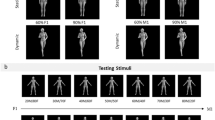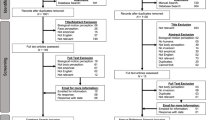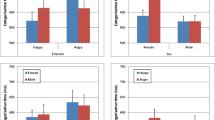Abstract
Prolonged exposure to a stimulus results in a subsequent perceptual bias. This perceptual adaptation aftereffect occurs not only for simple stimulus features but also for high-level stimulus properties (e.g., faces’ gender, identity and emotional expressions). Recent studies on aftereffects demonstrate that adaptation to human bodies can modulate face perception because these stimuli share common properties. Those findings suggest that the aftereffect is not related to the physical property of the stimulus but to the great number of semantic attributes shared by the adapter and the test. Here, we report a novel cross-category adaptation paradigm with both silhouette face profiles (Experiment 1.1) and frontal view faces (Experiment 2) as adapters, testing the aftereffects when viewing an androgynous test body. The results indicate that adaptation to both silhouette face profiles and frontal view faces produces gender aftereffects (e.g., after visual exposure to a female face, the androgynous body appears as more male and vice versa). These findings confirm that high-level perceptual aftereffects can occur between cross-categorical stimuli that share common properties.






Similar content being viewed by others
References
Barlow, H. B., & Hill, R. M. (1963). Evidence for a physiological explanation of the waterfall phenomenon and figural aftereffects. Nature, 200, 1345–1347.
Burr, D., & Ross, J. (2008). A visual sense of number. Current Biology, 8, 425–428.
Davidenko, N. (2007). Silhouetted face profiles: A new methodology for face perception research. Journal of Vision 7(4), 1–17. http://journalofvision.org/7/4/6/, doi:10.1167/7.4.6.
Davidenko, N., Witthoft, N., & Winawer, J. (2008). Gender aftereffects in face silhouettes reveal face-specific mechanisms. Visual Cognition, 16, 99–103.
Dickinson, J. E., & Badcock, D. R. (2013). On the hierarchical inheritance of aftereffects in the visual system. Frontiers in Psychology, 4, 472.
Georgeson, M. (2004). Visual aftereffects: Cortical neurons change their tune. Current Biology, 14, 751–R753.
Ghuman, A. S., McDaniel, J. R., & Martin, A. (2010). Face adaptation without a face. Current Biology, 20, 32–36.
Gibson, J. J., & Radner, M. (1937). Adaptation, after-effect and contrast in the perception of tilted lines. I. Quantitative studies. Journal of Experimental Psychology, 20, 453–467.
Golle, J., Lisibach, S., Mast, F. W., & Lobmaier, J. S. (2013). Sweet puppies and cute babies: Perceptual adaptation to babyfacedness transfers across species. PLoS ONE, 8, e58248.
Hayn-Leichsenring, G.U., Kloth, N., Schweinberger, S.R., & Redies, C. (2013). Adaptation effects to attractiveness of face photographs and art portraits are domain-specific. iPerception, 4, 303–316.
Hills, P. J., Elward, R. L., & Lewis, M. B. (2010). Cross-modal face identity aftereffects and their relation to priming. Journal of Experimental Psychology: Human Perception and Performance, 36, 876–891.
Huk, A., Ress, D., & Heeger, D. (2001). Neuronal basis of the motion aftereffect reconsidered. Neuron, 32, 161–172.
Javadi, A. H., & Wee, N. (2012). Cross-category adaptation: Objects produce gender adaptation in perception of faces. PLoS ONE, 7(9), e46079. doi:10.1371/journal.pone.0046079.
Kessler, E., Walls, S. A., & Ghuman, A. S. (2013). Bodies adapt orientation-independent face representations. Frontiers in Psychology, 4, 413.
Kloth, N., Schweinberger, S. R., & Kovacs, G. (2010). Neural correlates of generic versus gender specific face adaptation. Journal of Cognitive Neuroscience, 22, 2345–2356.
Kovács, G., Zimmer, M., Banko, E., Harza, I., Antal, A., & Vidnyanszky, Z. (2006). Electrophysiological correlates of visual adaptation to faces and body parts in humans. Cerebral Cortex, 16, 742–753.
Leopold, D. A., O’Toole, A. J., Vetter, T., & Blanz, V. (2001). Prototype-referenced shape encoding revealed by high-level aftereffects. Nature Neuroscience, 4, 89–94.
Lundqvist, D., Flykt, A., & Öhman, A. (1998). The Karolinska directed emotional faces. Stockholm: Karolinska Institute, Psychology section, Department of Clinical Neuroscience.
Mather, G., Verstraten, F., & Anstis, S. (1998). The motion aftereffect: a modern perspective. Cambridge, MA: MIT Press.
McCollough, C. (1965). Color adaptation of edge-detectors in the human visual system. Science, 149, 1115–1116.
Palumbo, R., Laeng, B., & Tommasi, L. (2013). Gender-specific aftereffects following adaptation to silhouettes of human bodies. Visual Cognition, 21, 1–12.
Schweinberger, S. R., Casper, C., Hauthal, N., Kaufmann, K. M., Kawahara, H., Kloth, N., et al. (2008). Auditory adaptation in voice perception. Current Biology, 18, 684–688.
Schweinberger, S. R., Zäske, R., Walther, C., Golle, J., Kovács, G., & Wiese, H. (2010). Young without plastic surgery: Perceptual adaptation to the age of female and male faces. Vision Research, 50, 2570–2576.
Skuk, V. G., & Schweinberger, S. R. (2013). Adaptation aftereffects in vocal emotion perception elicited by expressive faces and voices. PLoS ONE, 8, e81691.
Suzuki, S., & Cavanagh, P. (1998). A shape-contrast effect for briefly presented stimuli. Journal of Experimental Psychology: Human Perception and Performance, 24, 1315–1341.
Thompson, P., & Burr, D. (2009). Visual aftereffects. Current Biology, 19, R11–R14.
Webster, M. A., Kaping, D., Mizokami, Y., & Duhamel, P. (2004). Adaptation to natural facial categories. Nature, 428, 557–561.
Webster, M. A., & MacLeod, D. I. A. (2011). Visual adaptation and face perception. Philosophical Transactions of the Royal Society B, 366, 1702–1725.
Winkler, C., & Rhodes, G. (2005). Perceptual adaptation affects attractiveness of female bodies. British Journal of Psychology, 96, 141–154.
Zäske, R., Schweinberger, S. R., & Kawahara, H. (2010). Voice aftereffects of adaptation to speaker identity. Hearing Research, 268(1–2), 38–45.
Acknowledgments
We wish to thank Nicolas Davidenko for the silhouetted face profiles used in Experiment 1.1.
Author information
Authors and Affiliations
Corresponding author
Rights and permissions
About this article
Cite this article
Palumbo, R., D’Ascenzo, S. & Tommasi, L. Cross-category adaptation: exposure to faces produces gender aftereffects in body perception. Psychological Research 79, 380–388 (2015). https://doi.org/10.1007/s00426-014-0576-2
Received:
Accepted:
Published:
Issue Date:
DOI: https://doi.org/10.1007/s00426-014-0576-2




